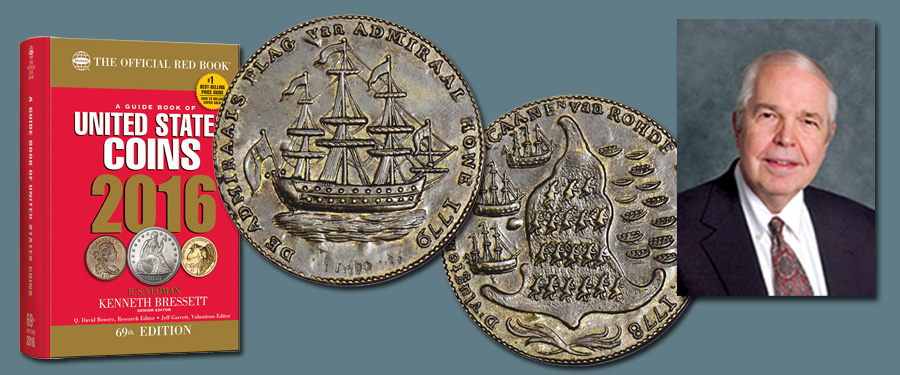
Welcome to the latest installment of my travel through the pages of A Guide Book of United States Coins. With your copy in hand you can turn to page 50 and follow this week’s discussion of Rhode Island Ship medals. Today these are available in two main collectible varieties, one with a wreath below the ship and one with without such an ornament. Very rare is one that has the word “vlugtende,” (which means “fleeing”) in the die.
Circumstances surrounding this issue, sometimes referred to as a token, are shrouded in mystery. These were hardly known to collectors on this side of the Atlantic until W. Elliot Woodward offered one in his sale of the Seavy Collection on June 21 and 22, 1864, at which time it sold for $40, an extraordinary amount at the time. By way of comparison, a Proof 1856 Flying Eagle cent was worth about $2! Woodward is one of the most prominent figures in 19th century numismatics. Hailing from Oxford, Maine, he moved to Roxbury, Massachusetts, where he opened the Mount Pleasant Apothecary, a drug store that also had books, used clothing, and other items for sale. Woodward was a Renaissance man, so to speak, and beginning in 1860 issued a string of auction catalogs that continued for several decades. In the early days his main competition was Edward Cogan, who played a distant second in terms of numismatic knowledge and accuracy. Today Woodward is little remembered, although he is deserving of inclusion in any Hall of Fame that exists.
The Rhode Island Ship medal has on the obverse an outline of an island with stylized soldiers superimposed. Ships are to the left and men in 13 whaleboats are fleeing to the right, a scene set in August 1778. The reverse has a sailing ship with sails furled and an inscription relating to the flight of Admiral Howe’s flagship from Narragansett Bay, Rhode Island, in October 1779.
The flight of the Continental Army on August 30, 1778, seems to be ridiculed on one side and on the other Admiral Howe’s flagship, attesting to his inability to retain the fruits of his victory, is satirized. One 19th century numismatist George T. Paine believed that it may have been struck in Holland by a sympathizer with the American cause, who intended one side to be a compliment to the United States on the successful retreat, and on the other a scorning of the British fleet. Michael J. Hodder has suggested that these were struck in England in 1780 as a propaganda piece, heralding an English victory, scarce at this point, with inscriptions to be read by the Dutch. This was published in the C4 Newsletter, Summer 2002 edition.
In correspondence with me, John Kleeberg suggests that the medal might be of Dutch origin, pro-British in sentiment, part of a series of Dutch political and satirical medals as part of the debate within that country as to whether the Dutch should enter the war against Britain (as they eventually did). Once again, and this is true across the spectrum of early numismatics, facts are scarce, leaving much opportunity for historical research. Today the Internet offers more opportunities than ever before in this regard.
On early issues, below Howe’s flagship, “vlugtende” was engraved, as noted above, an error that was effaced on the die used to strike most coins, after which a wreath was added covering where that word had been. This token is listed in the 1894 work, American Colonial History Illustrated by Contemporary Medals, posthumously by Wyllys C. Betts, who had passed away of pneumonia on April 27, 1887. Just as Sylvester S. Crosby’s Early Coins of America, published in 1875 remains a standard work today, so does the Betts volume. In fact, no successor to the Betts book has ever been written, although it is likely that if such were produced it would reach a wide audience.
See you next week.





